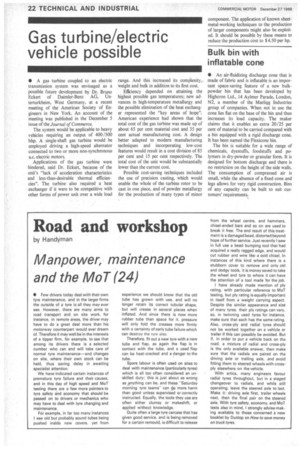Road and workshop
Page 24

If you've noticed an error in this article please click here to report it so we can fix it.
by Handyman
Manpower, maintenance and the MoT (24)
• Few drivers today deal with their own tyre maintenance, and in the larger firms the outside of a tyre is all they may ever see. However, there are many arms to road transport and on site work, for instance, in remote areas, the driver may have to do a great deal more than his motorway counterpart would ever dream of. Therefore it may well be in the interests of a tipper firm, for example, to see that among its drivers there is a selected number who can and will take care of normal tyre maintenance—and changes on site, where their own stock can be held, thus saving delay in awaiting specialist attention.
We have .indicated certain instances of premature tyre failure and their causes, and in this day of high speed and MoT testing there are a few more pointers to tyre safety and economy that should be passed on to drivers or mechanics who may have to deal with tyre changing and maintenance.
For example, in far too many instances I see old but probably sound tubes being pushed inside new covers, yet from experience we should know that the old tube has grown with use, and will no longer retain its correct tubular shape, but will crease in several places when inflated. And since there is now more rubber tube than space for it, pressure will only fold the creases more firmly with a certainty of early tube failure which can destroy the tyre also.
Therefore, fit out a new tyre with a new tube and flap, as again the flap is in contact with the tube, and a used flap can be heat-cracked and a danger to the tube.
Spare labour is often used on sites to deal with maintenance iparticularly tyres) which is all too often considered an unskilled duty; this is just about as wrong as anything can be, and these -SaturdaY morning tyre teams" can do more harm than good unless supervised or correctly instructed. Equally, the tools they use are often either clumsy or makeshift, or applied without knowledge.
Quite often a large tyre carcase that has given good service, and is being removed for a certain remould, is difficult to release from the wheel centre, and hammers, chisel-ended bars and so on are used to break it free. The end result of this treatment is a damaged bead, distorted beyond hope of further service. Just recently I saw in full use a bead bumping tool that had acquired a really ragged edge, and would cut rubber and wire like a cold chisel. In instances of this kind where there is a stubborn cover to remove and only old and dodgy tools, it is money saved to take the wheel and tyre to where it can have the attention of a tool made for the job.
I have already made mention of ply rating, with particular reference to MoT testing, but ply rating is equally important in itself from a weight carrying aspect. Despite the similar appearance and size of many tyres, their ply ratings can vary, so, in twinning used tyres for instance. make sure that each has the same rating. Also, cross-ply and radial tyres should not be worked together on a vehicle or trailer if this can possibly be avoided. But if, in order to put a vehicle back on the road, a mixture of radial and cross-ply is the only available answer, then make sure that the radials are paired on the driving axle or trailing axle, and avoid fitting them to steered wheels with crossply elsewhere on the vehicle.
With artics, many engineers favour radial tyres throughout, but in a staged changeover to radials, and while still operating, leave the steered axle to last. Make it: driving axle first, trailer wheels next, then the final pair on the steered axle. With tyre safety, economy, and MoT tests also in mind, I strongly advise making available to those concerned a new booklet by Dunlop on How to save money on truck tyres.












































































